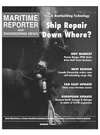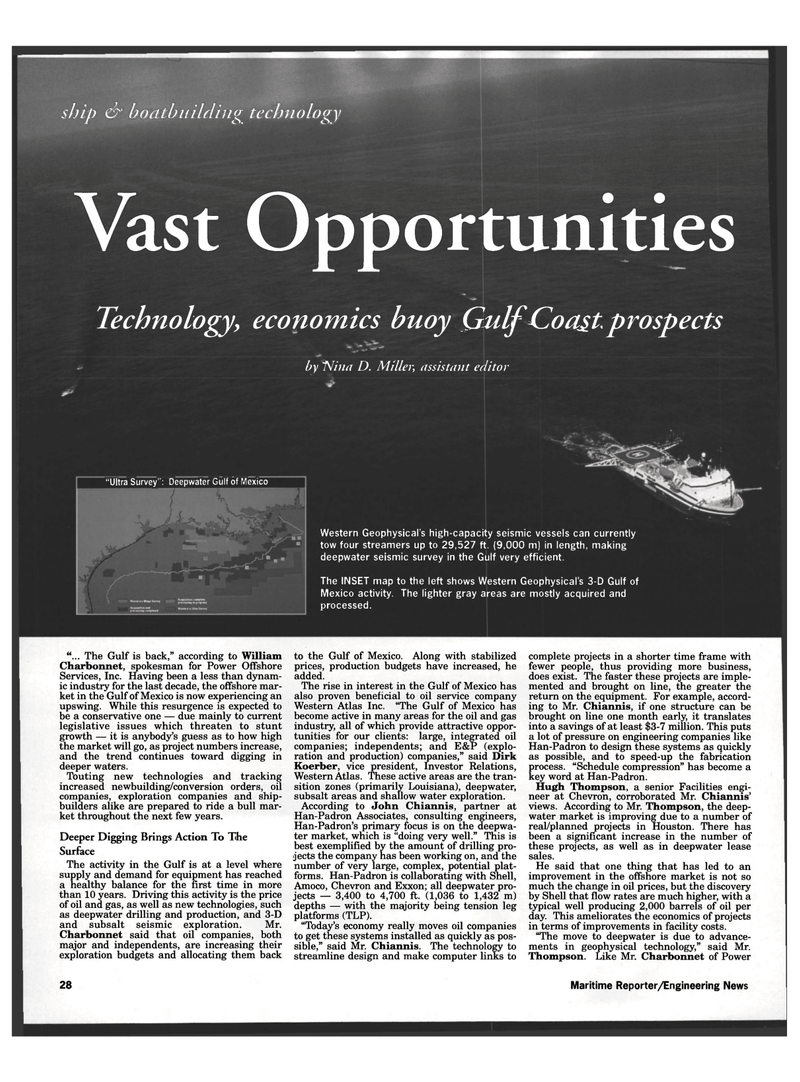
Page 26: of Maritime Reporter Magazine (August 1996)
Read this page in Pdf, Flash or Html5 edition of August 1996 Maritime Reporter Magazine
ship & boatbuilding technology
Vast Opportunities
Technology, economics buoy Gulf Coast prospects by "Nina D. Miller, assistant editor "Ultra Survey": Deepwater Gulf of Mexico
Western Geophysical's high-capacity seismic vessels can currently tow four streamers up to 29,527 ft. (9,000 m) in length, making deepwater seismic survey in the Gulf very efficient.
The INSET map to the left shows Western Geophysical's 3-D Gulf of
Mexico activity. The lighter gray areas are mostly acquired and processed. "... The Gulf is back," according to William
Charbonnet, spokesman for Power Offshore
Services, Inc. Having been a less than dynam- ic industry for the last decade, the offshore mar- ket in the Gulf of Mexico is now experiencing an upswing. While this resurgence is expected to be a conservative one — due mainly to current legislative issues which threaten to stunt growth — it is anybody's guess as to how high the market will go, as project numbers increase, and the trend continues toward digging in deeper waters.
Touting new technologies and tracking increased newbuilding/conversion orders, oil companies, exploration companies and ship- builders alike are prepared to ride a bull mar- ket throughout the next few years.
Deeper Digging Brings Action To The
Surface
The activity in the Gulf is at a level where supply and demand for equipment has reached a healthy balance for the first time in more than 10 years. Driving this activity is the price of oil and gas, as well as new technologies, such as deepwater drilling and production, and 3-D and subsalt seismic exploration. Mr.
Charbonnet said that oil companies, both major and independents, are increasing their exploration budgets and allocating them back 28 to the Gulf of Mexico. Along with stabilized prices, production budgets have increased, he added.
The rise in interest in the Gulf of Mexico has also proven beneficial to oil service company
Western Atlas Inc. "The Gulf of Mexico has become active in many areas for the oil and gas industry, all of which provide attractive oppor- tunities for our clients: large, integrated oil companies; independents; and E&P (explo- ration and production) companies," said Dirk
Koerber, vice president, Investor Relations,
Western Atlas. These active areas are the tran- sition zones (primarily Louisiana), deepwater, subsalt areas and shallow water exploration.
According to John Chiannis, partner at
Han-Padron Associates, consulting engineers,
Han-Padron's primary focus is on the deepwa- ter market, which is "doing very well." This is best exemplified by the amount of drilling pro- jects the company has been working on, and the number of very large, complex, potential plat- forms. Han-Padron is collaborating with Shell,
Amoco, Chevron and Exxon; all deepwater pro- jects — 3,400 to 4,700 ft. (1,036 to 1,432 m) depths — with the majority being tension leg platforms (TLP). "Today's economy really moves oil companies to get these systems installed as quickly as pos- sible," said Mr. Chiannis. The technology to streamline design and make computer links to complete projects in a shorter time frame with fewer people, thus providing more business, does exist. The faster these projects are imple- mented and brought on line, the greater the return on the equipment. For example, accord- ing to Mr. Chiannis, if one structure can be brought on line one month early, it translates into a savings of at least $3-7 million. This puts a lot of pressure on engineering companies like
Han-Padron to design these systems as quickly as possible, and to speed-up the fabrication process. "Schedule compression" has become a key word at Han-Padron.
Hugh Thompson, a senior Facilities engi- neer at Chevron, corroborated Mr. Chiannis' views. According to Mr. Thompson, the deep- water market is improving due to a number of real/planned projects in Houston. There has been a significant increase in the number of these projects, as well as in deepwater lease sales.
He said that one thing that has led to an improvement in the offshore market is not so much the change in oil prices, but the discovery by Shell that flow rates are much higher, with a typical well producing 2,000 barrels of oil per day. This ameliorates the economics of projects in terms of improvements in facility costs. "The move to deepwater is due to advance- ments in geophysical technology," said Mr.
Thompson. Like Mr. Charbonnet of Power
Maritime Reporter/Engineering News

 25
25

 27
27
